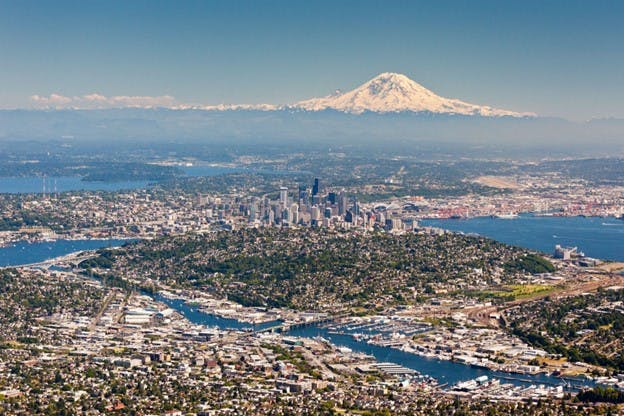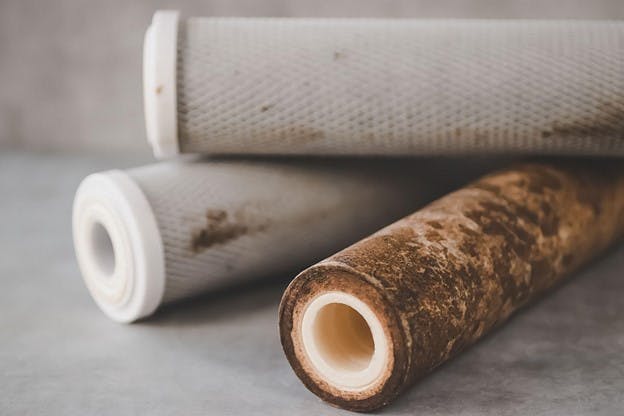Refer-A-Friend: Earn up to $200 for Yourself and a Friend When They Sign-up with HomeWater. Learn More
June 2023
Seattle Water Quality: Is It Safe to Drink the City’s Tap Water?
For the last 50 years, the world hasn’t been able to get enough of Seattle's cultural and technological contributions.
The trend-setting city gave us Starbucks, which revolutionized American coffee culture and provides people with a reliable spot to work or relax around the world. The thriving music scene made a mark that not only defined the 1990s but influenced almost everything after. Boeing made the world much smaller by revolutionizing air travel. Microsoft and Amazon revolutionized the tech and e-commerce industries. Oh, and let’s not forget about America’s favorite retailer: Costco.
It’s no wonder the city of Seattle’s population grew by a staggering 21% over the last decade. Today, metropolitan Seattle is home to 3.5 million people and even though the rainy city is nestled between the Puget Sound and Lake Washington, a population that poses some big challenges to the drinking water supply.
In this article, we’ll take a look at Seattle water quality to see how this innovative locale is dealing with this challenge.
Where Does Seattle's Water Supply Come From?
Unlike Seattle’s big city peers further down the coast, Seattle is fortunate to receive a lot of rain. Averaging 37 inches of precipitation each year, the gloomy city has a reliable source to feed its two large watersheds: Cedar River Watershed and the South Fork Tolt River Watershed.
The Cedar River Watershed is about 35 miles southeast of the city. The 90,000-acre area is managed by the Seattle Public Utilities (SPU) to protect the water supply from pollution. This watershed single-handedly supplies about 60% of Seattle’s total water needs.
The South Fork Tolt River Watershed is located about 40 miles northeast of Seattle and provides the remaining 40% of the city's water supply and is also managed by SPU.
How Is Seattle Water Quality?
While not perfect, Seattle's water quality is praised for having some of the best in the United States. One of the biggest reasons is that the city owns their watersheds and they are off-limits to the unsupervised public. This leaves very little chance for man-made contaminants to reach the city's water sources but they are still susceptible to natural contaminants like microbes and metals.
In comparison, most cities in the U.S. pull their drinking water from groundwater aquifers beneath the city, which may more easily contaminated than restricted watersheds. Those who pull from surface water systems like lakes and streams tend to use public water sources. These may be contaminated by public recreational use, untreated wastewater, stormwater runoff, agriculture, factories, and more.
To further ensure safe drinking water, Seattle Public Utilities tests for over 200 compounds as many as 50 times per day. The water is monitored throughout the collection and distribution process. SPU even has a tasting panel twice a month to be sure the water that serves all of King County meets expectations.
While Seattle's water quality is impressive and has low levels of regulated contaminants, all public water supplies have some areas they can improve.
Is It Safe to Drink Tap Water in Seattle?
According to Seattle’s Water Quality Report and the U.S. Environmental Protection Agency (EPA), Seattle tap water is safe to drink. It’s important to note that meeting regulatory standards doesn’t always mean water is safe, though.
The EPA, which is tasked with setting the safety standards for all U.S. public water suppliers, regulates only about 90 substances. But there are thousands of potential contaminants and many we don’t fully understand yet. Modern science is always advancing its understanding of our water supplies and what can create a public health risk.
According to the Environmental Working Group (EWG), a D.C.-based water watchdog, EPA regulation doesn’t always keep up with the most recent recommendations from scientists. In fact, the last update to water regulations was almost 20 years ago, even though our understanding of many contaminants has changed.
There is no reliable way to test for many lurking contaminants. For example, microplastics: We know they are prevalent everywhere in the world but testing freshwater samples for microplastics can be extremely challenging. Water suppliers aren’t required to do it.
What Contaminants Are in Seattle Water?
While Seattle water quality is commendable, the Environmental Working Group highlights some contaminants that have slipped through at concentrations scientists find to be too high.
Some of the biggest problems are disinfection byproducts. While chlorine in the amounts used in water treatment is considered safe for human consumption, the byproducts it creates when interacting with organic matter have the potential to cause problems.
Here are the most concerning impurities affecting Seattle’s water quality according to the EWG.
Haloacetic Acids (HAA5)
HAA5 is made up of five haloacetic acids: monochloroacetic acid, dichloroacetic acid, trichloroacetic acid, monobromoacetic acid, and dibromoacetic acid. These chemicals are known as disinfectant byproducts, as they result from disinfectants like chlorine interacting with organic matter in water. Long-term exposure to HAA5 can lead to cancer.
Levels of HAA5 in Seattle water have exceeded what the EWG recommends for safety by 321 times:
- EPA maximum allowance: 60 parts per billion (ppb)
- EWG recommended maximum: 0.1 ppb
- Seattle maximum contaminant level: 32.1 ppb
Haloacetic Acids (HAA9)
HAA9 includes all of the contaminants from HAA5 but adds bromochloroacetic acid, bromodichloroacetic acid, chlorodibromoacetic acid, and tribromoacetic acid. These are also disinfectant byproducts and are cancer-causing.
Levels of HAA9 in Seattle water have exceeded what the EWG recommends for safety by 455 times:
- EPA maximum allowance: No legal limit
- EWG recommended maximum: 0.06 ppb
- Seattle maximum contaminant level: 27.3 ppb
Total Trihalomethanes (TTHMs)
TTHMs — like the haloacetic acids above — are formed when chlorine interacts with organic compounds in drinking water. They’re also known to be carcinogenic. This category is made up of four chemicals: chloroform, bromodichloromethane, dibromochloromethane, and bromoform.
Levels of TTHMs in Seattle water have exceeded what the EWG recommends for safety by 216 times:
- EPA maximum allowance: 80 ppb
- EWG recommended maximum: 0.15 ppb
- Seattle maximum contaminant level: 32.4 ppb
Chromium (Hexavalent)
Chromium is a common heavy metal contaminant often found in U.S. water supplies. It’s both naturally occurring and an industrial byproduct. Although it’s a known carcinogen, the EPA still doesn’t regulate it.
Chromium levels in Seattle water have exceeded what the EWG recommends for safety by 5.8 times:
- EPA maximum allowance: No legal limit
- EWG recommended maximum: 0.02 ppb
- Seattle maximum detected level: 0.116 ppb
Does Seattle Water Need to Be Filtered?
By making the main watersheds private, Seattle has protected the freshwater resources Seattleites rely on from most synthetic types of pollution. However, with the water still sourced from nature, it’s impossible to shield it from natural environmental impurities.
Chlorine is introduced to treat these problems, which can create cancer-causing disinfection byproducts. Another concern in Washington state is that some water service lines and home plumbing still contain lead. Lead is very dangerous, especially for children and pregnant women.
High-quality water filtration systems can protect your faucet from all of these things and more.
Is Seattle Water Hard or Soft?
Seattle's water is considered moderately hard, with hardness levels varying depending on the source of the water supply. However, the hardness levels are generally lower than other U.S. cities because so much of Seattle’s water is from rain and snowmelt rather than underground aquifers.
When water travels underground or through rocks and soil, minerals are dissolved and absorbed into it. The concentration of minerals like calcium and magnesium contained in the water determine how hard the water is.
While hard water doesn’t present a danger to people, it can cause mineral buildup and corrosion in your pipes, appliances, and home surfaces. This scale buildup can be very hard to clean and it gives bacteria and mold a place to attach onto. These minerals can also damage clothing and reduce the effectiveness of soaps and detergents.
If you’re dealing with hard water in Seattle, you’ll be surprised just how much easier your life becomes once you get a high-quality water softener.
Does Seattle Fluoridate Its Water?
Like many cities in the United States, water providers in Seattle do add fluoride to their drinking water. This is done as a public health initiative to help control tooth decay. While many people are OK with fluoride in their water, others want to have more control over their fluoride intake and would rather just remove it.
If you would like to remove the fluoride from your Seattle water, the best option is a reverse osmosis water filter system. Other methods like carbon filters and boiling will not remove fluoride.
How to Have the Best Home Water Quality in Seattle
The SPU has made strides to ensure the city of Seattle enjoys some of the best tap water in the country. By protecting the watersheds, water providers have removed much of the risk of manmade contamination but not the risk from nature.
Seattle water still contends with microbial impurities, heavy metals, disinfection byproducts, and lead. If you have concerns about your Seattle water quality, HomeWater can help.
HomeWater's UPSTREAM 4-Stage Whole Home Water Filters can improve your water quality by removing impurities like sediment, heavy metals, microorganisms, and more. You can even attach a salt-free water conditioner and make your hard water problems a thing of the past.
For a more accessible installation, our 4-Stage Reverse Osmosis Under Counter Water Filter can remove contaminants such as chlorine, lead, copper, and even fluoride.
Seattle’s water is great, but it can always be made better with HomeWater.


